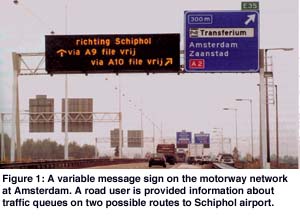In class and the second homework we studied how users responded to a simple transportation network given certain costs for different segments. We saw that given a certain network, the nash equilibrium is not necessarily socially optimal (the joint strategy is not a social welfare maximizer). This fact is one problem facing urban planners as they attempt to create the most efficient road network for all users. This issue is addressed in a thesis by Tom Bellemans, Traffic Control on Motorways . Several solutions are proposed, however a system of dynamically restricting access to certain routes is the focus. The paper proposes traffic lights be installed at onramps to allow the ramp to be closed in certain high traffic conditions on the highway. This can of course help reduce the overall number of users that can take a certain path, but can also mitigate traffic jams by limiting access to the extent that the traffic jam does not back up to block the corresponding off-ramp. The paper presents a model that minimizes highway conjestion, on-ramp queue length and queue time. It shows that effective ‘on-ramp metering’ can reduce congestion and increase traffic flow. The paper models several situations including lane closure due to an accident or road work.
Such a control system takes the approach of forcing users into a joint strategy that is a social welfare maximizer. Another approach discussed is a variable-cost metering system used on roadways in Singapore. This system adjust the toll that is charged for a given route based on the time of day and traffic condition.
Another problem that appears in reality is that users do not necessarily know the instantaneous cost of a given route, and will choose a route that is not a best response to the current network conditions, collectively deviating from the Nash Equilibrium. This is most evident in rush hour traffic. Without instantaneous knowledge of the traffic conditions ahead, a user may easily become locked into a traffic jam when taking an alternate route would have been much faster. In an attempt to address this issue, a number of municipalities have implemented real time traffic information that is available to users of major highways or busy traffic routes. A short article published by the European Research Consortium for Informatics and Mathematics,
Dynamic Route Control for Motorway Networks, describes current implementations and discusses areas for further research. Below is an example cited in the article of an implementation in Amsterdam (See caption)

Similar systems exist elsewhere. In New York highway signs typically alert users of current delays ahead or even planned future delays eg. construction. I-70 in Colorado provides estimated ‘travel times’ to approaching cities although alternate routes are not suggested. In Amsterdam, an online traffic map shows current congestion levels and is accessible by cell phone.
It is clear that there are a number of possible ways to improve traffic flow on highways and roads. Simply providing drivers with up to date information about the current ‘cost’ of a segment enables them to enter in a joint strategy that is a Nash Equilibirum for the actual state of the network, as opposed to that for an incorrectly assumed network state. Traffic flow can be improved beyond the ‘natural’ N.E. either by introducing monetary costs to segments that offset their travel time costs (making the N.E. a social welfare maximizer) or by forcibly restricting traffic in a strategic way as to ensure a socially optimal traffic flow (regardless of N.E.).


[…] Read More proneax […]
[…] A number of recent posts have been looking at models of how agents interact on networks, sometimes strategically and sometimes more simply. proneax discusses research on designing solutions to traffic congestion, in the spirit of our discussion of the Braess Paradox. This topic was also the focus of Tim Roughgarden’s research when he was a Ph.D. student here with Eva Tardos. […]